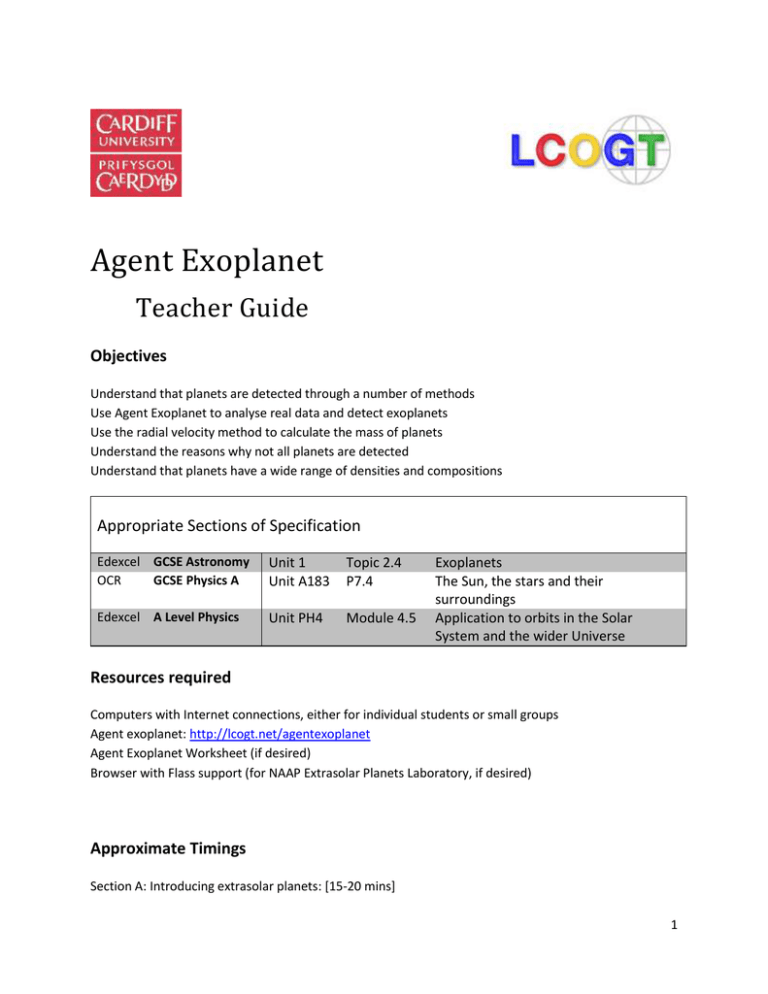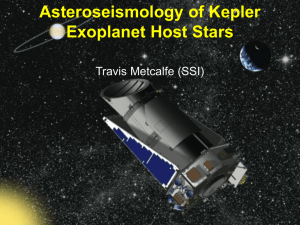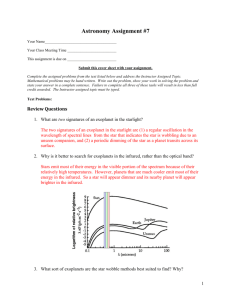Agent Exoplanet Teacher Resource to Share
advertisement

Agent Exoplanet Teacher Guide Objectives Understand that planets are detected through a number of methods Use Agent Exoplanet to analyse real data and detect exoplanets Use the radial velocity method to calculate the mass of planets Understand the reasons why not all planets are detected Understand that planets have a wide range of densities and compositions Appropriate Sections of Specification Edexcel GCSE Astronomy OCR GCSE Physics A Unit 1 Unit A183 Topic 2.4 P7.4 Edexcel A Level Physics Unit PH4 Module 4.5 Exoplanets The Sun, the stars and their surroundings Application to orbits in the Solar System and the wider Universe Resources required Computers with Internet connections, either for individual students or small groups Agent exoplanet: http://lcogt.net/agentexoplanet Agent Exoplanet Worksheet (if desired) Browser with Flass support (for NAAP Extrasolar Planets Laboratory, if desired) Approximate Timings Section A: Introducing extrasolar planets: [15-20 mins] 1 Section B: Agent Exoplanet [20-30 minutes] Section C: Using the radial velocity method [20-30 minutes] Section D: Compositions of exoplanets [20 mins] Preparation Before doing this activity with students, you will want to go to Agent Exoplanet and complete the activity yourself with planet CoRoT 2b so that you are familiar with the website and the process. It is crucial to try Agent Exoplanet yourself before leading the activity. Some of the online demonstrations require Flash support in the browser. This is fairly common, but check that this is enabled before using them. A: Introducing extrasolar planets Use the teacher presentation to illustrate this section. The teacher presentation includes a number of slides suitable for introducing extrasolar planets, or exoplanets. These include the history of their discovery and the ways in which they are detected. The first discovery of an exoplanet was in 1992. Since then over 1000 exoplanets have been found using several different methods. Detection methods One of these methods spots exoplanets whose orbit is lined up so that part of it passes between its star and us here on the Earth. When the exoplanet gets between its star and us we call it a transit. You can sometimes see transits in our own Solar System when Mercury or Venus pass directly between the Sun and the Earth. LCOGT have used their telescopes to take a sequence of images of a particular star-field over a period of time. During that time there was a transit of an exoplanet around one of the stars. Agent Exoplanet gives you tools to spot these transits by measuring the brightness of the star as the exoplanet passes in front of it and blocks some of the starlight. This allows us to determine the size of the planet. Since planets are much smaller than stars, the dip in light is very, very small. 2 Another method uses the fact that as a planet orbits a star, it also causes the star to move slightly. This “wobble” can be detected, and used to determine the mass of the planet. A third method is “microlensing”, where an unseen planet causes the light from a background star to be briefly magnified. From this method we learn about the mass of a planet, but not its size or its orbit. Planet properties For planets which have a known mass and size, we can calculate their average density. Introducing Transits Astronomers at Las Cumbres Observatory are investigating exoplanets - planets which orbit stars other than our Sun. One of the methods they use is observing transits. If a planet orbiting another star passes between us and the star, it blocks some of the light reaching us from the star and this is called a transit. By measuring a star’s brightness before, during and after a transit, scientists can learn about the size of the planet, and the size of its orbit. An online laboratory describing how the planet and star affect the observed transit is available as part of the Nebraska Astronomy Applet Project: http://astro.unl.edu/naap/esp/animations/transitSimulator.html Students can explore the way in which a planet’s size affects the amount by which the light dips. It also clearly demonstrates that only orbits seen almost edge-on ever cause transits. B: Agent Exoplanet Using Agent Exoplanet, students will study known exoplanets using images taken by LCOGT’s telescopes. They measure the brightness of a star while a planet moves between it and our viewpoint. They can examine as many images, from as many exoplanet transit events, as they like and contribute to understanding the properties of each exoplanet. With Agent Exoplanet, the students will measure the brightness of several stars, including the target star, in each image over a long period of time. As the observing conditions change, such as the clarity of the sky and the blurring from the atmosphere, the brightnesses of all the stars in the image will experience the same amount of dimming and distortion. By comparing several of the stars with the star that hosts a transiting planet, we should be able to detect a dip in its brightness due to the planet passing in front. Some of the slides in the presentation include screenshots of Agent Exoplanet Tips and Suggestions 3 ● The background science, an introductory video and instructions for the project are on the Agent Exoplanet website under Mission Briefing: http://lcogt.net/agentexoplanet/briefing/ ● You can either have all the students complete the activity with the same planet or planets, or you can have different groups work on different planets and then report back to the class. ● Students can examine as many images as they like, from a handful, to several full transits. They can also challenge themselves and improve their accuracy by using large numbers of calibrator stars. Doing the Activity The student worksheet contains all the steps necessary for them to complete the activity, which should be completed individually or in small groups (2-3 people). Ask students to read the Mission Briefing and watch the introductory video: http://lcogt.net/agentexoplanet/briefing/ You can either have all the students complete the activity with the same planet or planets, or you can have different groups work on different planets and then report back to the class. Students can examine as many images as they like, from a handful, to several full transits. They can also challenge themselves and improve their accuracy by using large numbers of calibrator stars. Wrap-up If students or groups of students did different planets, ask them to order the planets in various ways: ● smallest to largest ● nearest to farthest from Earth ● shortest orbital period to longest ● shortest orbital radius to longest C: Radial velocity method Introducing the radial velocity method 4 Just as a star’s gravitational pull causes a planet to move in its orbit, the gravitational pull of the planet on the star will also cause the star to move, though by a much smaller amount. The speed at which the star moves depends on the mass of the star, the mass of the planet, and the time it takes for the planet to orbit the star. The amount of wobble can be calculated by considering where the centre of mass of the combined system (the star and the planet) is. A practical demonstration can include a metre ruler with a large balls (or blob of plasticine etc.) on one end, representing the star, and a smaller one on the other end, representing the planet. The balancing point of the metre ruler marks the centre of mass of the system, and is the point at which the two objects orbit. Exactly this process takes place in our Solar System, with Sun moving due to the influence of Jupiter. An online demonstration of this is available as part of the Nebraska Astronomy Applet Project: http://astro.unl.edu/naap/esp/detection.html. From Earth, we can rarely observe the wobble of the star directly, as it is too small. However, we can detect the Doppler shift in the star’s light as it moves towards or away from us. The students should think about how the tilt of the planet’s orbit affects what we see from Earth. Since we are only measuring the component of the velocity parallel to the line of sight from Earth, the true velocity may be higher, depending on the inclination of the system. An online demonstration of the Radial Velocity method is available as part of the Nebraska Astronomy Applet Project: http://astro.unl.edu/naap/esp/animations/radialVelocitySimulator.html Simulated measurements of the radial velocities of a number of the stars observed in Agent Exoplanet are available in the presentation, and in the student question sheet (though the values for Qatar 1b are based on real data). The students should use the radial velocity measurements to calculate the mass of the planet, using the formula provided. A teacher presentation includes the answers they should get. Tips and Suggestions The student spreadsheet contains the formula needed to calculate the mass from the radial velocity. More able students may be able to enter the formula themselves The teacher spreadsheet has all the values filled in, for the purposes of checking answers. This formula includes the period of the planet’s orbit; alternatives include the orbital radius. Since these are all planets which transit their star, their orbits are nearly edge-on, so the radial velocity is very close to the actual velocity. Doing the activity Students should enter the radial velocity measurements into Excel or Logger Pro and plot them. 5 The maximum and minimum points can be used to calculate the velocity of the star around its orbit. The radial velocity of the star, combined with its orbital period and the mass of the parent star, can be used to calculate the mass of the planet. Using LoggerPro to plot Radial Velocity measurements The first step is logging all of the data correctly into the columns to the left. All of the data points should start to resemble a sine wave on the graph to the right of the columns, but the sine wave isn’t ready for taking data just yet. Next we lay a best-fit sine wave down on the graph by selecting ‘curve fit’ from the list of icons above the plot (curve fit is the icon second from the right). 6 After selecting ‘curve fit’ the window above will appear. First you must select the appropriate curve to fit onto the plot (as we can see in the window, I selected wine wave). Then you select ‘Try Fit’ to see if the curve fits the plot, and if it does you can then select okay. You will now have a sine wave fitted to the data. The box connected to the plot contains the data you needed to make calculations from the graph. It may not be clear from the image (the font is fairly small), but the value for the amplitude is around ‘0.2178 +/- 0.016’. D: Composition of Exoplanets The combination of a mass and a size allow us to calculate an average density. By comparing with known materials, we can think about what the planet’s composition might be. Tips and Hints If not all the stars have been used in previous sections, use the relevant data from the teacher spreadsheet If you want to extend it to more planets, then information is available on the Extrasolar Planet Encyclopedia: http://exoplanet.eu 7 The student spreadsheet contains the formula for calculating the density. More able students may be able to enter these themselves. Planets are denser in their centres than near their surfaces. Doing the Activity Use the measured masses and sizes to calculate the average densities of the planets Compare these with the densities of some common materials, and deduce what the composition of the planets might be. Wrap-up An additional exercise may be to compare these densities with the average densities of planets in our Solar System. This information is provided in the teacher spreadsheet. 8








